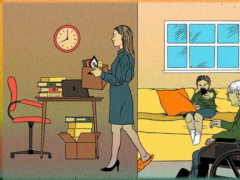NEW YORK — Jason LaCroix felt privileged to work from home, especially as a father to two young children. He needed flexibility when his son, then 6, suffered a brain injury and spent 35 days in intensive care.
LaCroix, a senior systems engineer based in Atlanta, took time off and then worked from home while managing his son’s care and appointments. But LaCroix was laid off last February from that job, where he’d been working remotely for five years. His new role requires him to spend four days a week in a company office and commute for three hours a day.
“I want to be around for my kids,” LaCroix, 44, said. “It’s very important for me to be around for my son, because we almost lost him.”
Heading into 2025, thousands of workers face an unsettling reality: after years of working from the comfort of home, they must return to the office full-time for the first time since the coronavirus pandemic or look for new work.
Employees at Amazon, AT&T and other companies have been called back to the office five days per week. President-elect Donald Trump has vowed to fire federal workers who don’t show up to do their jobs in-person.
“People always want to have flexibility,” said Mark Ma, a University of Pittsburgh associate professor of business administration. “I have never heard anyone telling me that I thank my job because it’s so rigid in its schedule.”
Ma researched what happened when technology and finance companies in the S&P 500 stopped allowing employees to work remotely in recent years. He found the companies experienced high turnover rates after implementing return-to-office mandates, especially among female employees — who often have childcare responsibilities — and senior-level executives.
“Over the years, people have adjusted their lives. They’ve figured out, ‘Oh wow, I can pick my kids up for school. Wow. I can caretake for my aging parents while I am still working,'” said Shavon Terrell-Camper, a therapist and mental wellness coach. “Once you have tasted work-from-home … it’s difficult to see your life going back to something that could’ve been unsustainable from the beginning.”
Workers and experts have advice to share about how to navigate the changes when an employer calls you back to the office.
Employers can compromise if their goal is to increase how much time staff members spend together. Ma suggests an “employee-choice” approach which gives teams the authority to decide how many days they will work in the office as a group.
If that’s not an option, employees also can ask to adjust their hours. LaCroix leaves home at 5 a.m. and works in the office until 2 p.m. to reduce time in traffic and allow him to be home when his kids get off the bus after school. His employer requires eight hours in the workplace but is flexible on which hours.
“A lot of people are pushing back, and they are trying to work out scenarios to see what type of flexibility does exist within the mandate,” Terrell-Camper said.
Some are coming up with work-arounds that aren’t endorsed by upp





